PRINCETON, NJ -- The political composition of U.S. adults held fairly steady in 2010 compared with 2009. Conservatives remained the largest group, followed by moderates and then liberals. At 35%, the percentage of moderates has declined to a new low, highlighting the increased political polarization that has occurred over the past decade.
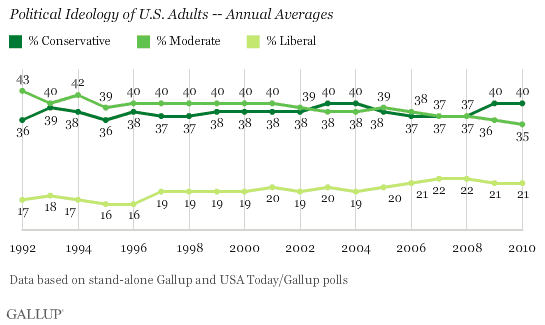
Gallup measures Americans' political ideology by asking respondents to define their views as very conservative, conservative, moderate, liberal, or very liberal. The trends represent annual averages of stand-alone, multiday Gallup surveys conducted each year, with more than 26,000 interviews in the 2010 data set.
In 2010, as in prior years, relatively few Americans described themselves as either very conservative (10%) or very liberal (6%). The vast majority of Americans favor the more temperate political labels.
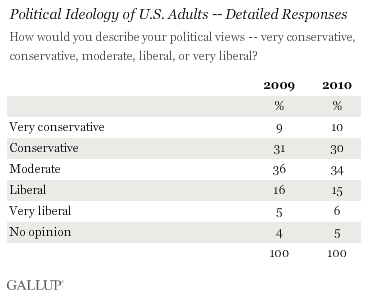
Fewer people in all three party groups call themselves moderate today than did so in 2002, but the decline is particularly steep among Republicans. The percentage of Republicans calling themselves moderate fell from 31% in 2002 to 27% by 2006, and now stands at 23%. There has been a commensurate increase in the percentage of Republicans calling themselves conservative, now at a record-high 72%.
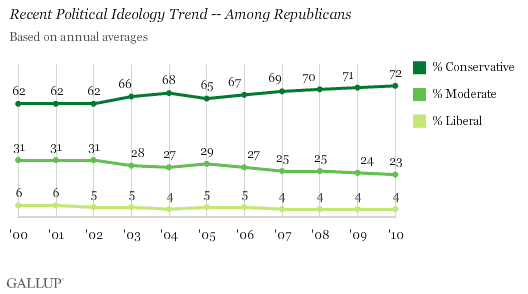
Among Democrats, Gallup trends document declines in the proportion of moderates as well as conservatives. At the same time, the percentage of Democrats identifying as liberal has climbed from 29% in 2000 to a record-high 40% today.
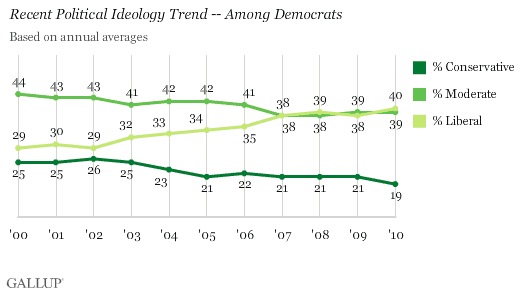
The ideological orientation of independents was fairly steady from 2000 through 2008, but since 2009, their views have followed the same path as Republicans', becoming less moderate and more conservative. Still, the slight plurality of independents remain moderate.
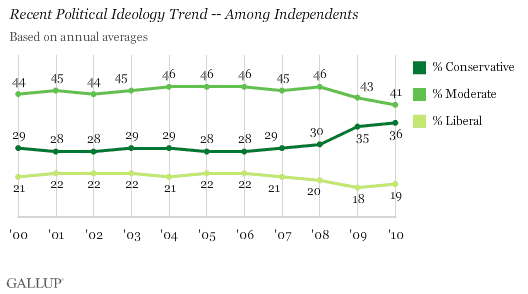
Conservatism in 2010 Peaked in Second Quarter
Although the percentage of conservatives among U.S. adults averaged 40% in 2010, it varied slightly during the year, peaking at 42% in the second quarter (after a 41% reading in the first quarter), in the first few months after passage of the landmark healthcare reform act. The conservative ID subsequently fell to 40% and 39% in the third and fourth quarters, and will bear watching in 2011.
Bottom Line
While the political pendulum in Washington can swing widely, Americans' political ideology, like their party identification, tends to shift more gradually. Such a shift has been underway in recent years. While the changes are not large, they are unmistakable. Moderates are growing fewer in number while the percentages of conservatives and liberals have expanded. Conservatism has gained ground among Republicans and independents, while the growth in liberalism is strictly among Democrats.
Survey Methods
Results are based on aggregated data from Gallup polls conducted in 2010, each based on telephone interviews with 1,000 or more national adults, aged 18 and older. For results based on the total sample of 26,417 national adults, one can say with 95% confidence that the maximum margin of sampling error is ±1 percentage point.
Other results are based on aggregated Gallup surveys of approximately 1,000 national adults each, aged 18 and older. Sample sizes for the annual compilations range from approximately 10,000 to approximately 40,000. For these results, one can say with 95% confidence that the maximum margin of sampling error is ±1 percentage point.
In addition to sampling error, question wording and practical difficulties in conducting surveys can introduce error or bias into the findings of public opinion polls.
Interviews are conducted with respondents on landline telephones and cellular phones, with interviews conducted in Spanish for respondents who are primarily Spanish-speaking. Each daily sample includes a minimum quota of 150 cell phone respondents and 850 landline respondents, with additional minimum quotas among landline respondents for gender within region. Landline respondents are chosen at random within each household on the basis of which member had the most recent birthday.
Samples are weighted by gender, age, race, Hispanic ethnicity, education, region, adults in the household, cell phone-only status, cell phone-mostly status, and phone lines. Demographic weighting targets are based on the March 2009 Current Population Survey figures for the aged 18 and older non-institutionalized population living in U.S. telephone households. All reported margins of sampling error include the computed design effects for weighting and sample design.
In addition to sampling error, question wording and practical difficulties in conducting surveys can introduce error or bias into the findings of public opinion polls.
For more details on Gallup's polling methodology, visit www.gallup.com.
